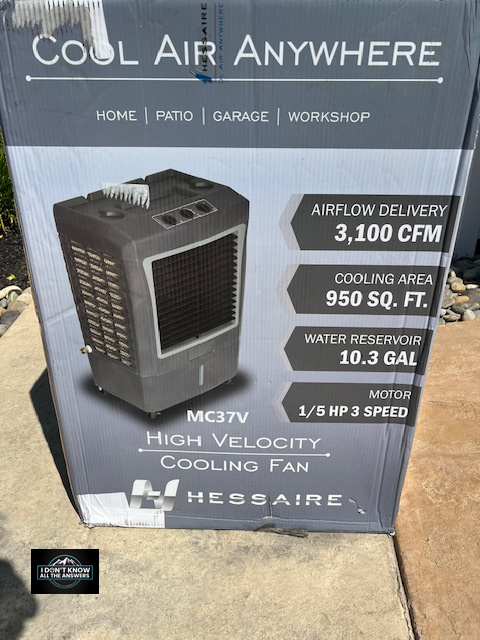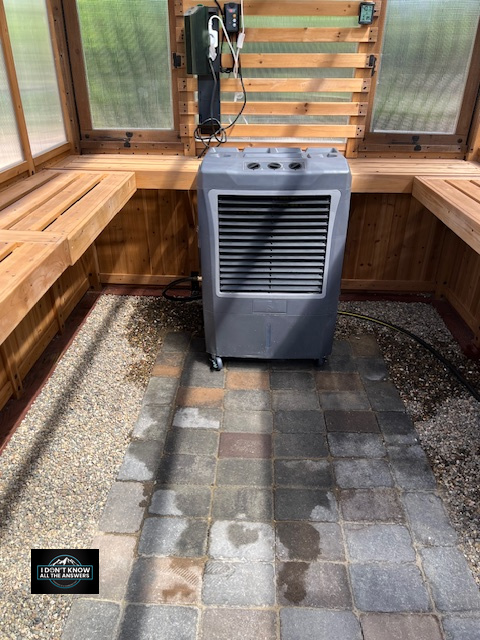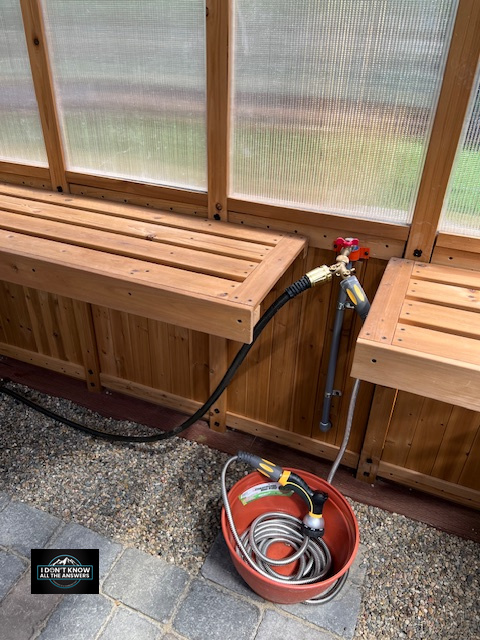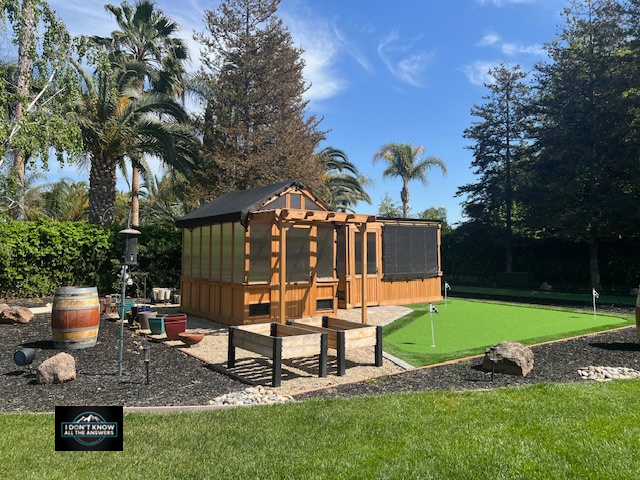If you’ve spent time nurturing a greenhouse, you know that regulating its temperature is often one of the trickiest parts. A greenhouse can feel like a haven for your plants one moment but turn into a sauna or an icebox the next. Last year, I acquired my first greenhouse, and the temperature was consistently much higher during the warmer months than I had expected! After unsuccessful attempts (learning opportunities) last year, I’ll admit that I gave up on controlling the temperature in our greenhouse. Fans and cooling shade cloths were insufficient, but Jim and I are now resuming our efforts.
We’re starting fresh this year, armed with new tools and more determination. One of our steps is investing in a swamp cooler.



What is a Swamp Cooler, and why did we add it to our Greenhouse?
A swamp cooler, or evaporative air cooler, is a simple yet eco-friendly way to keep your home cool, especially in a hot, dry climate. Swamp coolers use water evaporation to lower temperatures rather than relying on energy-hungry refrigeration systems like traditional air conditioners. Here’s how it works: Hot, dry air is pulled into the unit and passed over water-soaked pads, where the water evaporates and absorbs heat, cooling the air before it’s circulated back into your space. This process, known as evaporative cooling, works best in dry climates where the air can absorb more moisture. Beyond being energy-efficient, swamp coolers can boost humidity levels, making the air feel more comfortable in arid regions. They come in various sizes, from portable units perfect for single rooms to larger systems that can cool your entire home. Plus, with minimal components and no refrigerants to worry about, maintenance is usually a breeze.
Let’s break down the fundamental challenges and solutions to balancing the temperature inside your greenhouse.
The Challenges of Greenhouse Temperature Regulation
Whether you’re a seasoned plant enthusiast or just starting to nurture your greenhouse dreams, here are some key challenges you may face when trying to maintain an ideal climate for your plants:
- Overheating During Sunny Days
Even in early spring, greenhouses can heat up quickly when the sun beats down, which may stress and kill your plants.
- Temperature Swings
Maintaining consistency can be difficult, especially in climates with unpredictable weather or large day-to-night temperature differentials.
- Cold Nights
While sunny days might warm your greenhouse, chilly nights can sap the warmth. Protecting your greenhouse from excessive heat loss is crucial.
- Ventilating Without Losing Heat
Balancing proper ventilation to expel excess heat without losing too much warmth can be tricky.
- Managing Humidity
Temperature and humidity are related. Too much moisture can lead to mold, fungi, and disease, while too little can dry out plants.
Simple and Effective Solutions for Temperature Regulation
After a lot of research (and trial and error), here are some solutions I’ve found for maintaining better temperature control in your greenhouse:
1. Ventilation
Good airflow is key to regulating heat and humidity. Proper ventilation allows warm air to escape on hot days and helps prevent stagnant, overly moist air from creating problems.
- Automatic Vent Openers: These ingenious tools can open vents as temperatures rise, ensuring your plants stay comfortable without you having to keep an eye on the thermometer all day.
- Fans: Circulating fans are great for moving the air evenly throughout the greenhouse.
2. Shading
Hot, sunny days can turn your greenhouse into an oven if you’re not careful. That’s where shading comes in.
- Shade Cloths: These simple fabric coverings can reduce the intensity of sunlight filtering through to your plants. Depending on your plants ‘ needs, options with varying levels of shading—from 30% to 90% —are available. We purchased 70% to start with and then added 90%.
- Paint-on Shade: If you’re looking for a seasonal solution, there are paints specifically designed to reduce light intensity and provide temporary shade during the peak months.
3. Heating Systems
A reliable heating system becomes essential when nighttime temperatures dip or cold weather strikes.
- Heaters (electric or propane-based): A small electric space heater with a thermostat can keep temperatures consistent during the colder months.
- Thermal Mass: This involves using materials like water barrels or stones to absorb heat during the day and release it at night, helping to buffer temperature swings.
4. Swamp Coolers (Evaporative Coolers)
This year, we took the plunge and ordered a swamp cooler to help cool things down in the summer. A swamp cooler draws warm air through wet pads, which evaporate the water, cooling the air before it’s released into the greenhouse. In a future post, I’ll share more about its installation process and the routine maintenance it requires.
Here’s what I’ve found so far about these systems:
- Advantages:
- They’re energy-efficient, using far less electricity than air conditioners.
- They’re cost-effective to run and maintain.
- They add moisture to the air, a perk in dry climates or arid areas.
- Drawbacks:
- They’re suited only for dry climates. If you’re in a humid area, a swamp cooler won’t work either, and it might even create overly damp conditions.
- They require routine cleaning to prevent mold and mildew buildup.
I’m cautiously optimistic about this new addition to our greenhouse. It’ll be perfect for combating the hot, dry days ahead, but regular maintenance will be key to its success.
5. Monitoring Tools
Investing in a reliable thermometer or climate control system can make it easier to manage your greenhouse temperatures. You can track temperature fluctuations and adjust your heating and cooling strategies.
What I’ve Learned (and What You Can Try, Too)
Take heart, all my fellow plant enthusiasts grappling with fluctuating temperatures. You’re not alone, and there’s hope! Overheating, freezing nights, and humidity woes are issues we all face. But with the right tools and techniques, we can make a significant difference and create an ideal environment for our plants.
Here’s a quick recap of what I am trying:
- Use tools like vents, fans, and shade cloths during the warmest parts of the day to maintain proper airflow and reduce overheating.
- For those chilly nights, invest in a heater and consider adding thermal mass for a natural temperature buffer.
- Experiment with cooling solutions like swamp coolers in a dry climate.
- Track everything. A simple thermometer can help you manage and tweak your setup over time.
I won’t fill my greenhouse with plants until I master the temperature. Meanwhile, I advise giving yourself grace if you struggle with temperature control. It’s a learning process; we’re all growing along the way, just like our plants.
Remember, you’re not alone in this journey of greenhouse temperature regulation. I’d love to hear about your strategies and experiences in the comments. And don’t forget to check back—I’ll share updates on how well the swamp cooler works. Here’s to healthy, happy plants in every greenhouse! 🌱
References:
How to protect your plants from frost – Glow Gardens. https://glowgardencentre.com/blogs/news/how-to-protect-your-plants-from-frost
Greenhouse Cooling Systems. https://www.greenhousemegastore.com/collections/evaporative-cooling#:~:text=While%20some%20plants%20and%20people,plants%20are%20nice%20and%20comfy.
Thank you for reading this blog post. If you have any questions or comments, please leave them in the Comments section below.
Copyright © 2019. I Don’t Know All The Answers, Nikki Mastro.
All of my photographs and documents are copyrighted.
No part of this website, including text, photographs, and documents, may be reproduced, stored in a retrieval system, or transmitted in any form or by any means without written permission from the copyright holder. All unauthorized use is strictly prohibited. If you choose to copy or share any information from my site, you must provide a link to the source. I appreciate your cooperation.
For further information concerning “I Don’t Know All The Answers,”
– Website and Blog: https://www.idontknowalltheanswers.com
– Facebook: https://www.facebook.com/Nikki.L.Mastro/
– Instagram: https://www.instagram.com/i_dont_know_all_the_answers/
– Linkedin: https://www.linkedin.com/in/nikki-mastro-05455a3a/
– YouTube Channel: https://www.youtube.com/@idontknowalltheanswers1954

